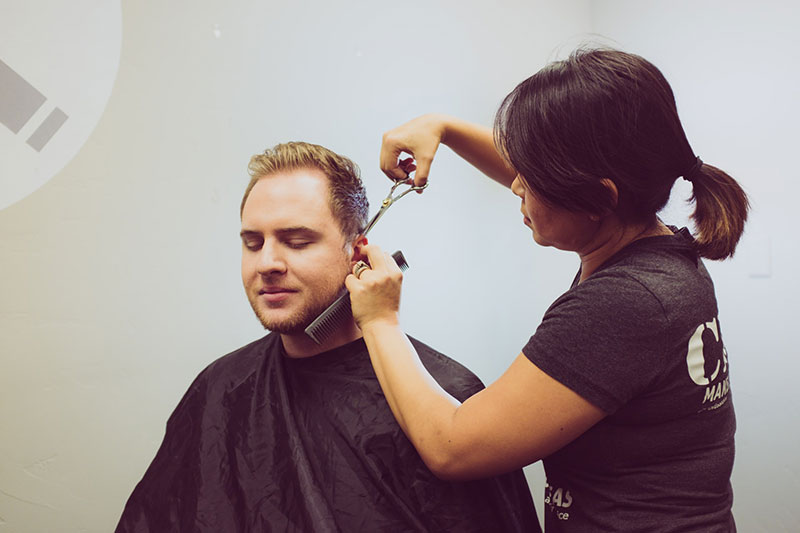Do you aspire to become a good, if not the best manager in your salon, or one that you are assigned to manage? Being a stylist is not always the ultimate goal of those who graduated from the cosmetology program. Some attended hair school to start their salon business, some want to work under established beauty brands, and some prefer to manage a salon.
Salon managers supervise the daily operations of a beauty salon, and their duties include making sure that the salon has all the necessary resources to run smoothly. It is vital to keep both customers and staff satisfied and delighted, and most importantly, they have to make sure that the salon is generating profit. This article created by our team at Trafft (a great app for any salon) will provide you with tips on the best way to manage a salon.
What is Salon Management?

Salon management refers to the management of the salon’s overall daily operations. The focus is on generating customers and profit through performance levers such as customer value and vendor management, marketing strategy, and delivery of services. This task is usually carried out by either the salon manager or owner.
There are many types of salon business models. Some salons are commission-driven, some implement regular fixed compensation, some are booth renters, and some run salon suites. These varying business models present different challenges that require different solutions.
However, regardless of the salon business model, there are universal principles that salon owners and managers can follow to establish a work environment and culture where the staff is motivated and productive. This article provides 12 tips for effective salon management.
Tips on how to manage a salon
Create Your Vision
Having a clear vision drives business toward success. It is always important to create a clear goal, whether short or long term, to steer the business in the right direction.
Are you planning to expand your salon within a year? Win an award or accreditation? Or meet the sales target? Whatever your vision is, put it into words and share it with the people you work with. Rally your team to work with you towards the same goal and make sure no one gets left behind.
Connect the Dots
Always explain the rationale behind the rules, policies, procedures, and standards implemented in the salon to the staff, as they might have interpreted such rules differently.
Make sure the salon staff understands that their work performance affects the quality of customer experience offered by the salon. It also entails that their performance has an impact, not only on the success of the salon but on their career development as well.
Communication is Crucial
Regular communication with the staff is one of the key factors behind a smooth business operation. Hold regular staff meetings to present updates, agendas, and address issues.
Make sure to follow the 3 P’s, Plan, Prepare, and Present. Engage the team in planning for promotions and new marketing ideas. Always include and consider the opinions of the staff in key decision-making processes.
Get Close to Your Staff, but Not Too Close
In a quirky work environment like a salon, it is sometimes hard to draw a line between keeping it professional and making it fun.
This is a challenge for salon managers. Setting the boundary between being strict and being lenient is tough, however, keep in mind that to be successful, you should try to maintain a perfect balance between the two. It’s important that your actions and decisions don’t breed resentment from your staff.
You may begin by gaining your staff’s trust and remaining generally polite. Listen to their stories, and value them as human beings, and at the same time, provide constructive feedback and maintain accountability.
Lead by Example
An effective leader always puts their words into action. As the salon manager, leading by example shows the staff what is possible.
It helps visualize the connection between performance measures and positive outcomes, and the merits of improving customer experience. You could do this by demonstrating how being proactive in promoting retail products and extra services will increase profits.
Use Customer Complaints
Customer reviews, a log of complaints, and how they were solved, make a good source of information about the quality of the salon’s services.
They indicate how customers are taken care of, how the staff performs, or if the salon amenities need to be improved. It is important to formulate procedures on handling customer complaints to guide the staff on how to resolve issues when the occasion arises.
It is also important to keep a register of complaints and resolution to address the cause of the issue, avoid repeating the same problem, and create best practices from it. The staff must always keep in mind that complaints should be taken seriously as they significantly affect the salon’s integrity.
Build a Strong Team as a Salon Manager
A salon manager’s tasks also include solving any pressing issues concerning human resources as quickly as possible. The staff needs to recognize the manager’s capability to provide effective solutions to any problems in the salon.
However, the best salon managers are not only good problem solvers, they are also great team builders. They must be able to show or teach their staff how to solve an issue with the right teamwork. A strong team is capable of addressing challenges as they arise. Conducting team-building exercises can help you build a strong, unified salon staff.
Make Communication Fun

A happy and positive work culture not only improves the well-being and productivity of the staff, but it also produces happy customers. It isn’t enough to just have regular communication with the staff, you also have to make sure that it is fun, positive, and engaging. You may hold monthly staff meetings on different themes, provide snacks and refreshments during meetings, or give a reward to well-performing stylists.
Make Product Companies Work for You
Salon managers are also responsible for replenishing stocks and ordering products for the salon. One valuable tip to keep in mind is that product companies usually provide free sample products to salons to gain a client.
Dare to ask for back-bar samples and education opportunities that they might offer for the stylists. This will not only benefit the staff, but it will also help you find the right products to sell in the salon.
Be Innovative

Beauty trends change rapidly. A trendy hairstyle, for example, rarely stays around for years. An iconic look today may look awkward next season. So a good salon manager will make sure that the salon business is adapting to the changing beauty trends. To stay on top of the salon industry, it is crucial to remain innovative. Allow your stylists to be creative, and encourage them to present new ideas for the salon services.
Don’t Forget the Marketing
Marketing is a key factor in driving customers into the salon. Place salon advertisements on local websites and publications that have a similar target market with the salon. Cross-promotions are also a good marketing strategy.
Promote your salon services to businesses that offer complementary services, like make-up artists, wedding planners, and image consultants. You may also offer discounts or create a customer referral program with exciting rewards and let your customers do the marketing for you. You can use the best QR Code generator to create QR Codes to discount your customers and to build an easy and secure referral ecosystem. Utilize major social media platforms such as Facebook, Instagram, and Twitter; and maximize their features at your disposal.
Automate Your Salon
Handling appointments and bookings can be time-consuming, and prevent you from doing other tasks. At this point, you may want to automate your salon and use business solutions software to streamline and integrate all the salon’s core business processes. This will help improve workflow and boost productivity.
Amelia is an excellent tool for appointments and event bookings. It is a WordPress booking plugin that is easy to install and use. Amelia has an intuitive design and good reviews. It offers seamless integrations with Google Calendar, PayPal, Stripe, and WooCommerce.
It also enables you to include as many services, staff members, and appointments as you need.
Another option is Trafft, a premium appointment scheduling software that aims to simplify and accelerate the booking and payment processes for salon managers and clients.
If you want to discover how Trafft and Amelia stack up against each other, delve into our in-depth Trafft vs. Amelia comparison.
FAQs about how to manage a salon
1. How do I attract and retain customers for my salon business?
A salon business needs to use marketing, top-notch customer service, and high-quality services to draw in and keep consumers. This can involve putting on special sales, setting up a loyalty scheme, giving tailored services, and making sure your team is properly trained to provide each customer a wonderful experience. Also, it’s crucial to concentrate on developing a good reputation through internet evaluations and recommendations from others.
2. What are the key factors to consider when setting up a salon?
A salon’s location, salon design, supplies, staffing, and regulatory regulations are important aspects to think about before opening one. The salon should have a welcoming and practical design, and the location should be clearly visible and accessible. To deliver excellent services, top-notch products and personnel are required, and hiring the appropriate people is essential. Obtaining permits, insurance, and abiding by safety and hygienic rules may all be legal requirements.
3. How can I effectively manage the day-to-day operations of my salon?
Scheduling, client care, and staff management must all be prioritized when running a salon on a daily basis. Customer satisfaction is largely dependent on effectively scheduling appointments and seeing clients on time. Greeting guests with warmth, offering refreshments, and swiftly addressing any complaints or concerns are all part of providing outstanding customer service. Making sure staff members are appropriately taught, motivated, and compensated is part of staff management.
4. How do I train and manage my staff to provide quality services to clients?
To offer clients high-quality services, management of the workforce and staff training are crucial. As part of this, basic training in salon services, customer service, and communication skills must be provided, as well as regular training to keep staff members abreast of new tools and methods. High expectations for professionalism and customer service should be placed on staff, and prizes and incentives can encourage them to go above and beyond.
5. What are the best marketing strategies to promote my salon business?
Social networking, email marketing, and referral programs are all useful marketing tactics for promoting a salon business. Building a following on social media sites like Instagram and Facebook is a terrific way to promote salon services. Special promotions and events can be promoted through email marketing. Referral programs, which allow returning customers to refer new customers in exchange for discounts or other benefits, can reward devoted consumers while bringing in new ones.
6. How do I manage my salon inventory, including products and equipment?
Tracking and keeping up with supplies, items, and machinery are all part of managing salon inventory. Monitoring inventory levels is essential to ensuring that there is sufficient stock to satisfy demand while preventing excess inventory that could result in waste. Equipment should be constantly maintained and repaired as necessary, and products should be stored appropriately to maintain their quality.
7. What legal and regulatory requirements do I need to comply with when running a salon?
Depending on the locale, there may be different legal and regulatory requirements for operating a salon, however they may include getting a license, getting insurance, and adhering to safety and sanitation laws. For your salon to run legally and properly, it’s crucial to learn about and comprehend these regulations.
8. How can I manage my salon finances, including expenses and revenue?
Keeping tabs on costs and income, controlling cash flow, and developing a budget are all part of managing salon finances. This entails keeping track of expenses like as rent, utilities, salaries, and inventory as well as developing a pricing strategy that promotes profitability while maintaining competitiveness. Making a budget can assist in locating areas where costs can be cut or income can be increased.
9. What are the common challenges faced by salon owners, and how can I overcome them?
Competition, employment troubles, and financial flow management are common difficulties salon businesses have. It’s critical to be abreast of market developments and emerging technology, to concentrate on delivering great customer service, and to continuously assess and tweak the business plan as necessary if you want to succeed in overcoming these obstacles.
10. How do I stay up-to-date with industry trends and new technologies to keep my salon competitive?
Keeping up with emerging technologies and market trends may keep a salon competitive. This can include visiting industry events and conferences, monitoring industry magazines and social media accounts, and investing in new equipment, salon scheduling software, and training for staff. Being an early adopter of new services or technologies might help your salon stand out from rivals and draw in new clients.
Ending thoughts on how to manage a salon
Regardless if you are a complete beginner or have years of experience in managing a salon, success involves building a solid foundation for a successful and sustainable beauty salon. These tips should help you do that.
Remember that a high-performing business thrives from establishing and maintaining good healthy relationships between salon staff and managers. This entails keeping the staff happy and motivated, and remaining calm when problems arise in the salon. If you lead by example and create a work culture that boosts morale, this will encourage a good work performance from the staff.



